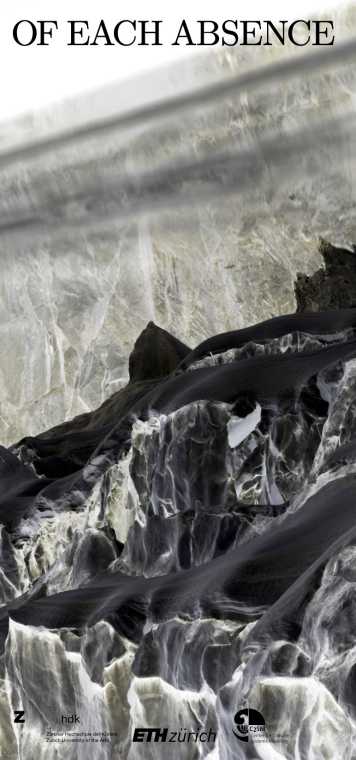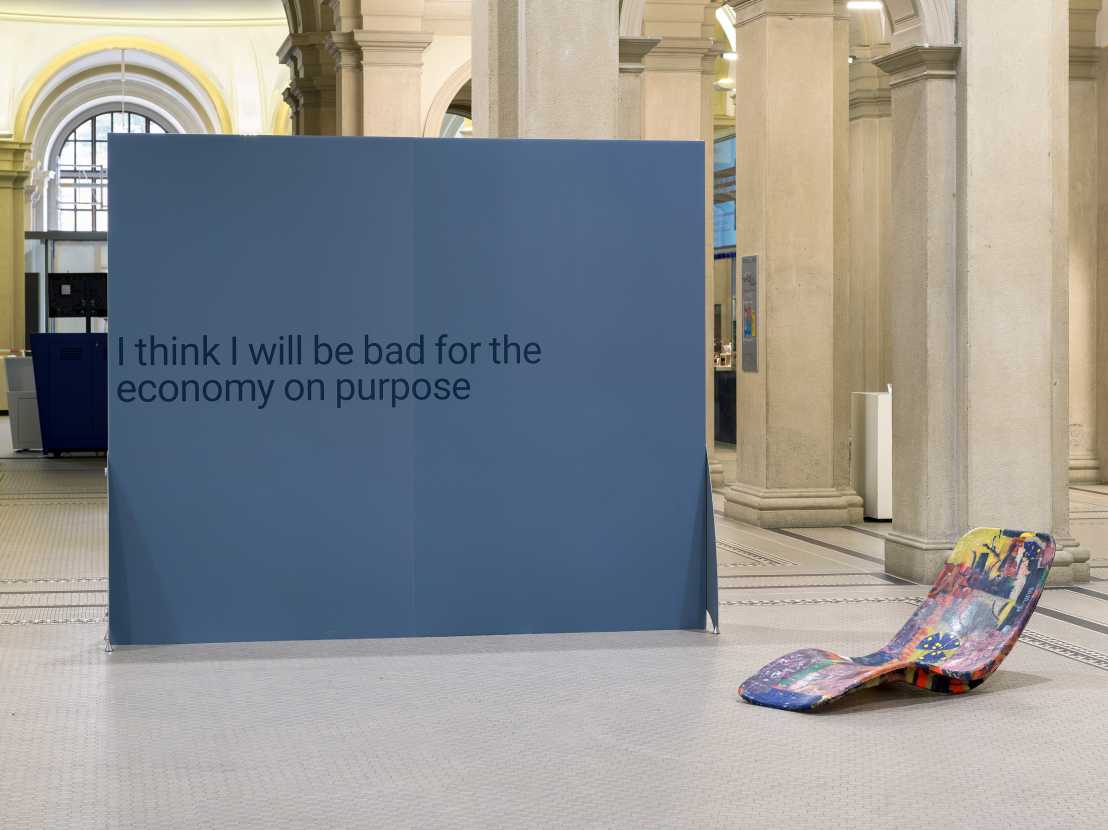ETH-Klimarunde: Art Exhibition (EN)
How can we respond to the complex knowledge on climate crisis? What does it mean to move from thinking to acting? What perspective can we take as artists?
Part 3 of ETH-Klimarunde
Opening Art Exhibition
Tuesday 31.10.2023, 7.15 p.m.
ETH Zurich, Main Building, Main Hall
Finissage: Art Walk
Thursday, 2.11.2023, 6 p.m. - 7.30 p.m.
ETH Zurich, Main Building, Main Hall
For the 10th anniversary of Klimarunde we have organised an art exhibition in collaboration with the Master Fine Arts of the Zurich University of the Arts (ZHdK). The art works are being created especially for this occasion by students of the Master's program and will be presented parallel to the Klimarunde.
The exhibition will be open to the public from October 31 to November 2, 2023 from 9 AM to 8 PM.
Finissage: Art walk
Explore the exhibition from the artists' perspective. Join us for an art walk through the exhibition led by the artists themselves. Explore the artworks from their perspective, uncover the stories behind the art, and learn about the creative process.
When: Thursday, November 2, 2023, from 6 p.m. to 7.30 p.m.
Where: ETH Zurich, Main Building, Main Hall
"Of Each Absence"
News of absence reaches us daily: Glaciers are thinning and retreating, leaving scars in the summer landscape. Lakes and rivers carry too little water. Droughts stunt harvests. In Winter it is the snow, whose absence leaves us with a brown, dirty landscape. In contrast, there is a surplus: of floods that wash away land and roads, paralyzing temperatures. Absence and presence are out of a natural balance. “The world dies of each absence”, writes Belgian philosopher Vinciane Despret. She recounts (man-made) extinction of migratory pigeons as part of a chronicle of extinction of humanity: “Every absence is a fragment of a slow dying. Everything that disappears is an irreparable loss for the earth and for humanity.” This dramatic disappearance can be applied to the climate crisis and the loss of the world as we know it.
Absence refers to inaction, apathy and a growing dilemma: We seek to understand, we strive to learn, but we seem to lack capacity to act. The potential of the world is limited by an accumulation of absences: Absence can be read as the blank space of a speculative future, something missing, a world that is not yet realised. We shape the “not yet there”, the future present, with actions of our present presence. Art and its production are full of contradictions and complexities, especially in illuminating pressing questions of the present. In other words, artistic responses to the climate crisis might not be the clear-cut messages we expect or demand from Science, but are rather intricately linked to knowledge and discourse about contemporary crises.
The works in the exhibition refer to visibility and speculative perspectives in the presence of complex processes. They reflect on complex nature-human relationships and are activists, in the sense that they place us in relation to nature, to our fellow human beings, reflect on economy and politics and challenge the language we use, through our ability to transform knowledge and to make it accessible in different ways.
– Judith Welter
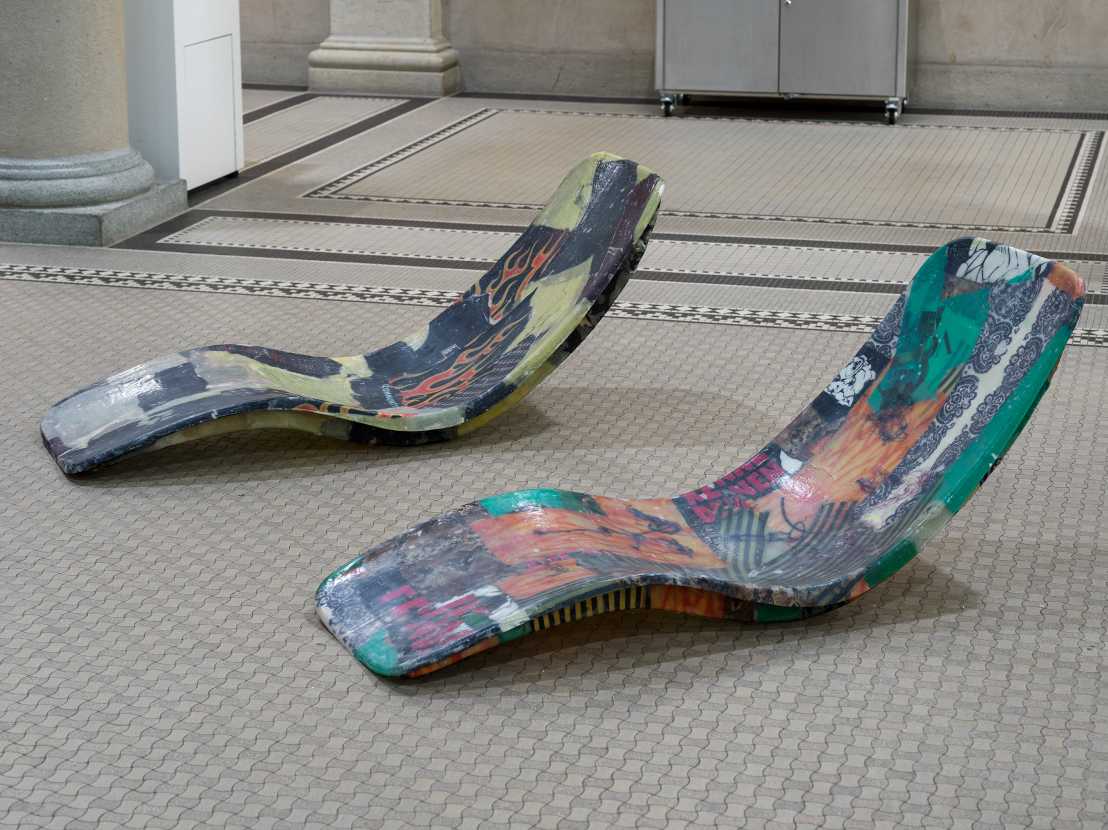
Martin Andereggen
Eurolaxxxers
2023
Disposed clothes, resin, fiberglass
6 parts, each: 160 x 63 x 60 cm
“Climate action now!” they shout on my iPhone. “Absolutely!” I hear myself say in a reassuring tone. I have been dozing in this old beach chair for an hour, and the sound of my voice makes me look around in embarrassment. No one seems to have noticed. Eurolax is the perfect name for this design, I think. Tilting your head back a little is enough effort to make the chair rotate into a vertical position, taking your mind away from the earth - towards the stars and the sky.
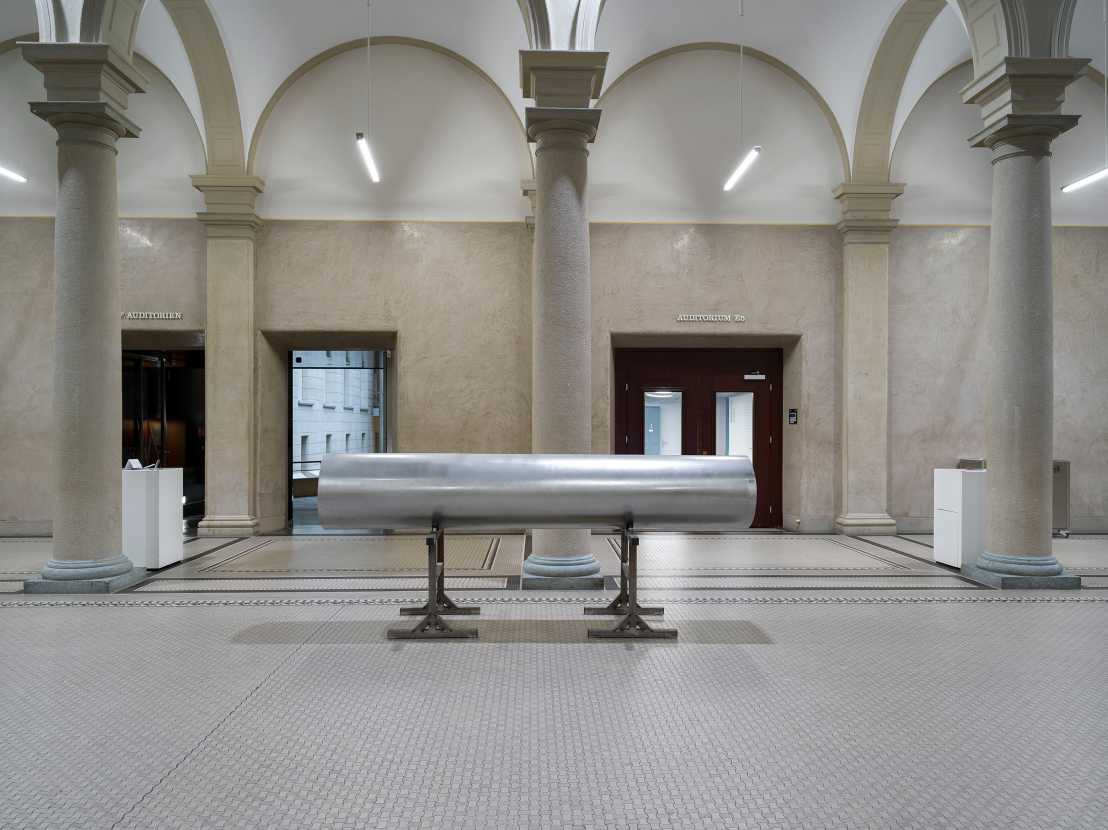
Aleyna Günay
Clarion Call
2023
Fiberglass, epoxy resin, paint, metal
300 x 60 x 130 cm
"Until yesterday, we were a family living peacefully in a small village.“
Not long ago, we decided to build a small house from scratch, located on the beach of the Barents Sea Beach. My little daughter, Eloise, helped collect biodegradable materials from the land we lived on. We wanted to have an environmentally friendly place to live together.
Eloise and her sister Jung were 6 years old when we adopted them from the orphanage of a former civil defense centre near Norway. After we adopted Jung, we realised that she had enhanced abilities. Extrasensory perception was one of them.
This has been a little bit of a summary of our family. Since we don't have anyone else living here, family means everything to us.
Yesterday Jung woke us up. It was too late for anything. We realised that we must have inhaled some toxic substance that someone had filled our house with while we were sleeping. Jung checked our body clock. It was as if we had been half asleep for years because of that substance. Someone was trying to incapacitate us.
Eloise and Jung left the house to figure out what's going on. We followed them. They were very brave to take over the situation. When Jung described what she saw, she said: ‘There were strangers doing construction on our land.’
And then Jung asked me, 'What are we going to do now, Mummy?' Eloise added, 'I want to know what's going on.’
I replied, 'They are looking for natural gas fields. We have to stay until they give up.’ Jung: ‘Perfect, exactly what I imagined.’ Barents Sea Beach, 2023
The Barents Sea Pipeline is a part of the Snøhvit development. The development consists of two fields that are already producing: Snøhvit and Albatross. The Askeladd field is the third discovery part of the Snøhvit development, which will be contributing to maintaining a full capacity utilisation at Melkøya LNG plant, outside the Norwegian city of Hammerfest. When developed, the Askeladd and Snøhvit total length of 195 km constitutes a world record of the longest subsea to shore tie-back distance. (1)
(1) FEED study on new pipeline in the Barents Sea Ramboll, July 7, 2018
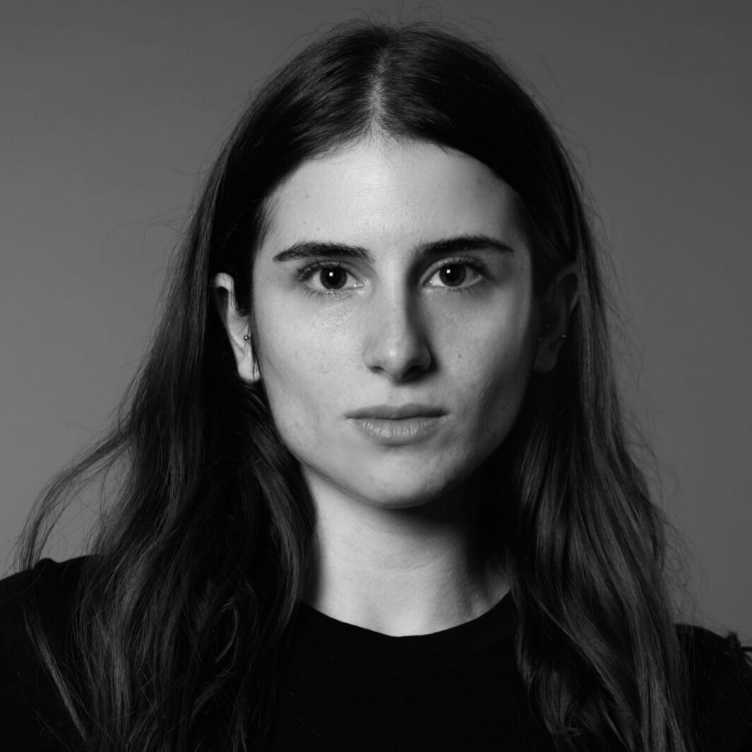
Aleyna Günay produces work in a variety of mediums including sculpture, installation, video, and sound. Her questioning areas are engaged with speculative fiction in non-traditional forms. She reflects a post-human approach as a way of thinking. Besides, she composes sound and performances. Lives and works in Zurich.
external page www.aleynagunay.com
Instagram: external page @aleynagunay
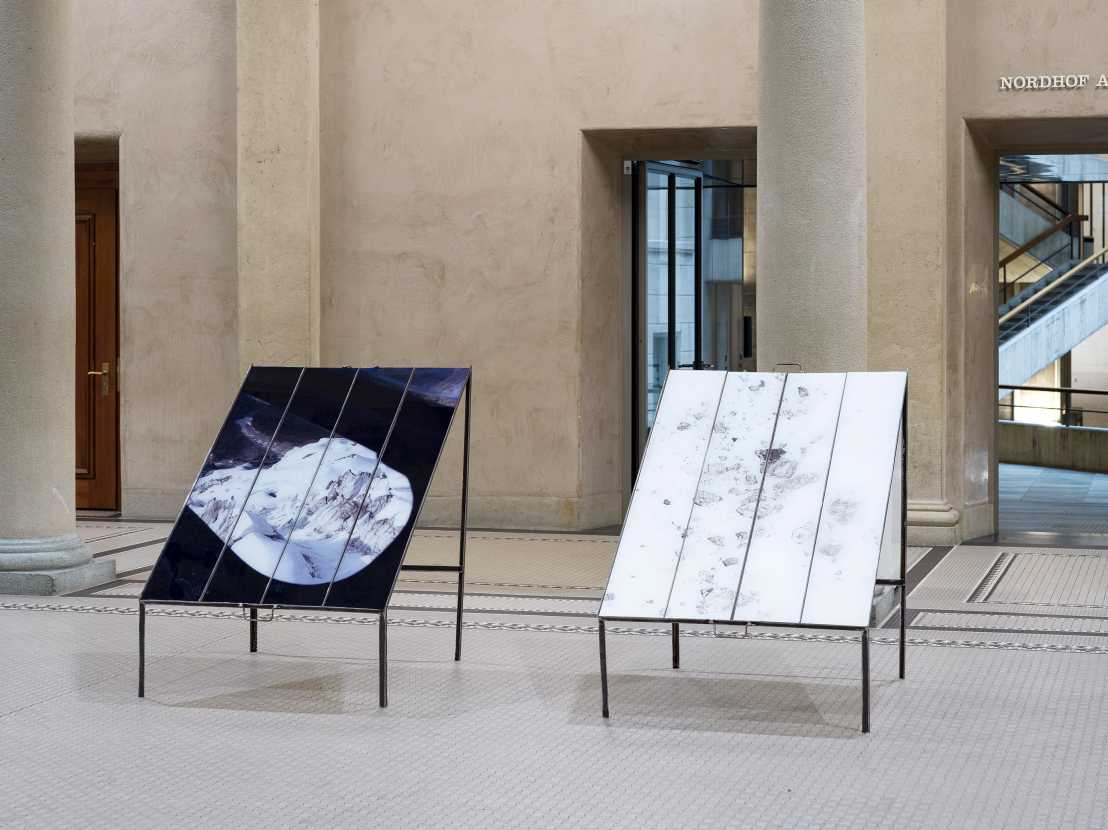
Arthur Heck
Tout Corps Prend Feu
2023
Steel, glass
2 parts, each: 150 x 100 x 125 cm
I made a series of photographs in collaboration with the teams of VAW's Glaciology group (Laboratory of Hydraulics, Hydrology and Glaciology, ETH Zurich). These images are fragments of my own experience of accompanying them on their fieldwork. They document an in-between time, a transition between a landscape that is disappearing and a new one that is taking shape. This photo series is a necessity for narrative rewriting. An emotional approach to issues of extinction. A desire for sentimental action.

Born in Strasbourg Arthur Heck (b. 2000) is a visual artist based in Zürich traversing the entanglements of intimacy, social condition, and sexuality in his work. Rooted in a working-class upbringing Heck’s visual production reflects a necessity of escape and a state of emergency musing over the relation between body and changes in space.
Instagram: external page @ahck._
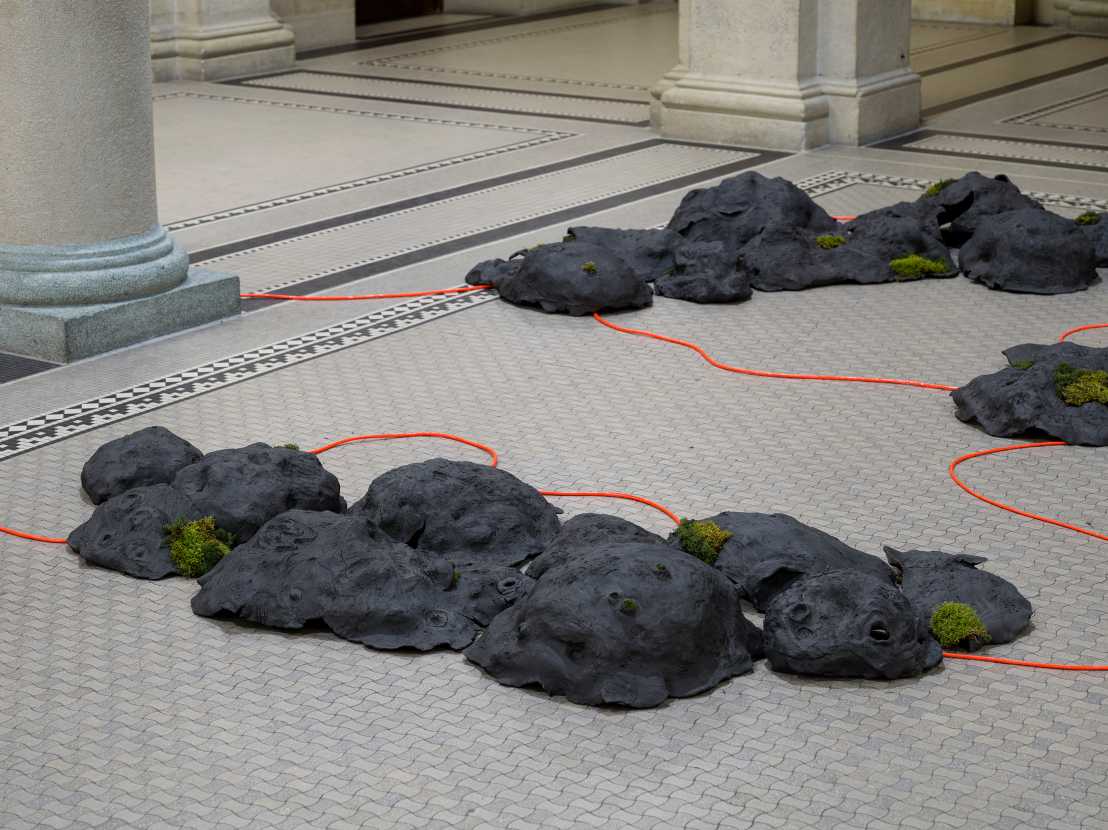
Francisca Patrocínio & Massimiliano Rossetto
fuzz fuzz
2023
Stoneware, moss, tape, audio system, 2-channel audio, looped
Dimensions variable
In fuzz fuzz, hand-moulded clay bodies emerge as echoes of natural spaces - an extension of a hypothetical inhabited landscape where encounters can take place. In exploring the relationship between organisms and the environment, the artists question ideas of sensibility and interdependence. The clay bodies are covered by moss belonging to the diverse group of bryophytes, small but vital plants made up of three distinct groups: mosses, liverworts and hornworts. Found in diverse ecosystems including forests, grasslands, wetlands, tundra and even cities, these plants play a critical role in the Earth's ecosystem, regulating water and nutrient cycles, providing habitats for other organisms and sequestering carbon from the atmosphere. With this work, the artist duo Francisca Patrocínio and Massimiliano Rossetto deepen the understanding of interconnections through sculpture and sound material, attempting to make a collective of organisms tangible. A place where bodies encounter each other in a landscape of wetness, fuzz and queer resilience.
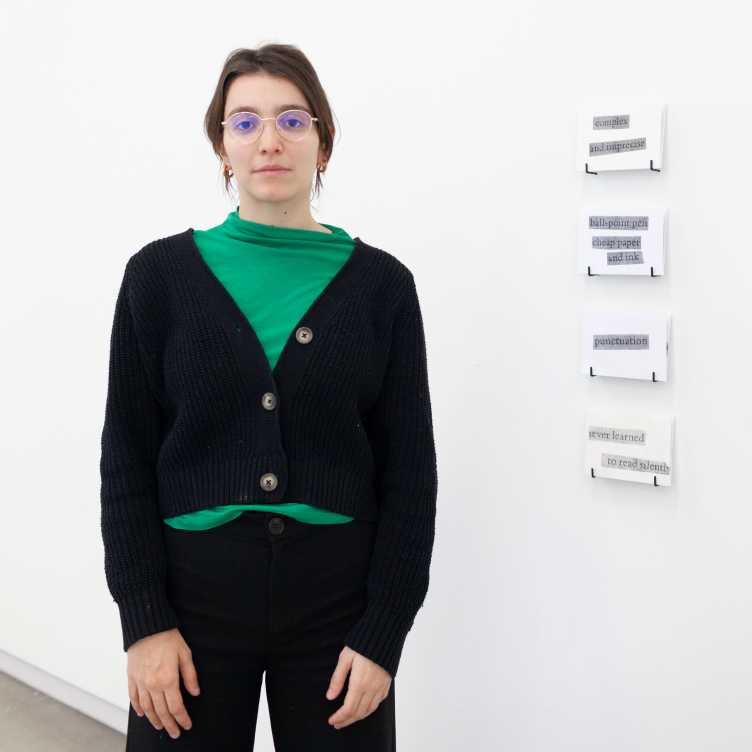
Francisca Patrocínio (1999, Porto) is an artist based in Zurich, with a background in sculpture and performance.
Bodies, objects and space emerge as central figures in her research and experimental based practice, where she reflects upon connections, relations and gesturality and the socio-political and cultural dimensions implied in these concepts in contemporaneity.
external page https://readymag.com/u4191845441/franciscacp/
Instagram: external page @franciscacpatrocinio
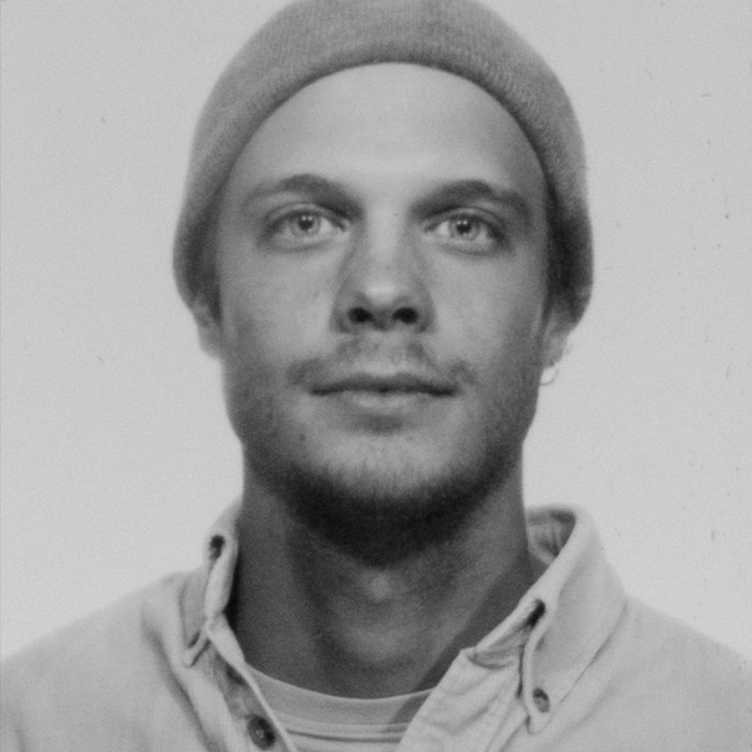
Massimiliano Rossetto (b. 1993) is a Swiss-Italian artist. He holds a Bachelor’s Degree in Fine Arts and Contemporary Photography from BLOO in Lyon. Currently pursuing a Master of Fine Arts at ZHdK - Zurich University of the Arts. His work focuses on humans interaction with the landscape through photography and sculpture, using multi-layered and ephemeral installations. He's based in Zurich and Berlin.
external page https://massimilianorossetto.com/
Instagram: external page @massin
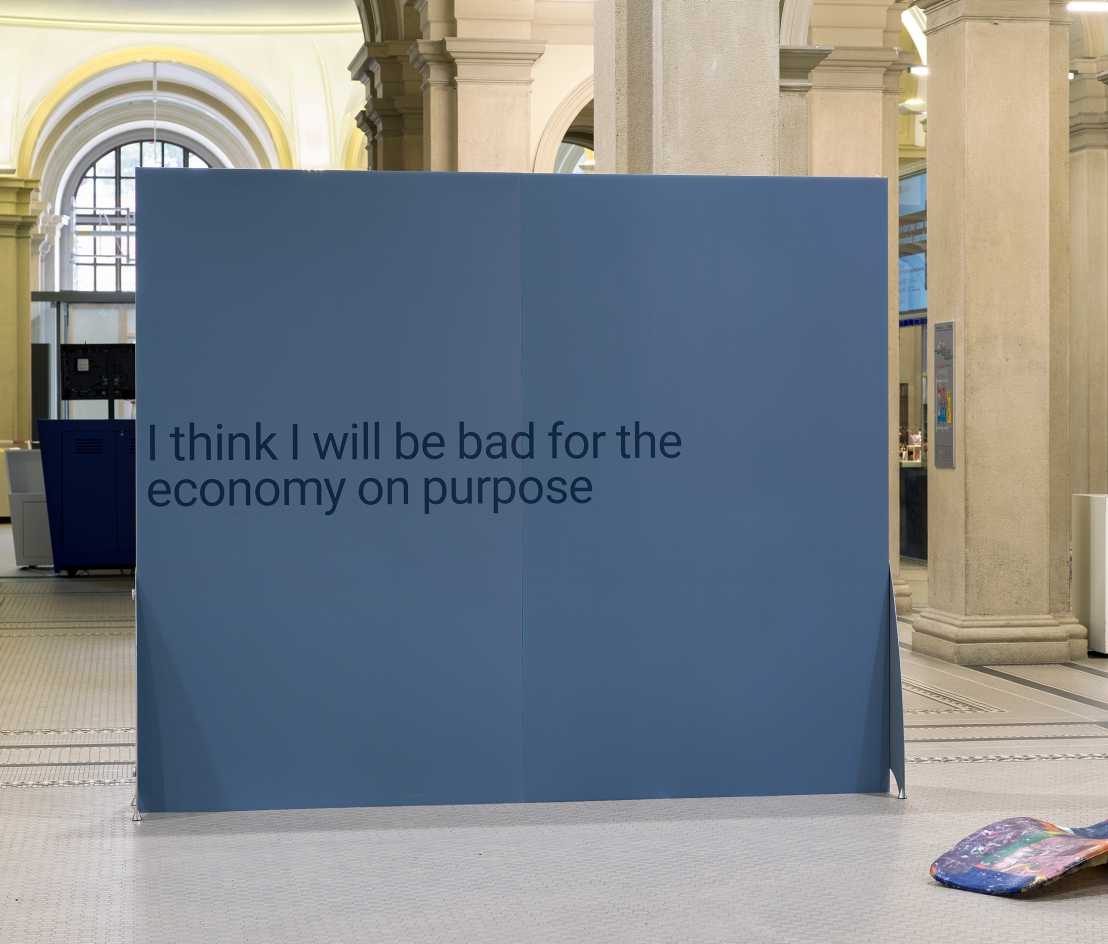
Schellinger Zaugg
I think I will be bad for the economy on purpose
2023
UV directprint on Forex, table talk
Dimensions variable
Why is it generally considered desirable to be good for the economy? Conversely why is it considered offensive to be bad for the economy?
The capitalist system has undoubtedly brought many benefits. Education, stability, social welfare or health for many people. But these benefits have been achieved through a reliance on steady growth, and therefore at the cost of exploitation of both people and the environment, to the extent that it now poses an existential threat to humanity.
So what possibilities does the individual have to take action? Bottom-up movements have always been important for social change. A rejection of status quo is a first step.
With I think I will be bad for the economy on purpose the artists offer ways to question existing systems and power structures. As part of the work, Schellinger Zaugg will run a public table talk, in which they discuss the topics with an audience.
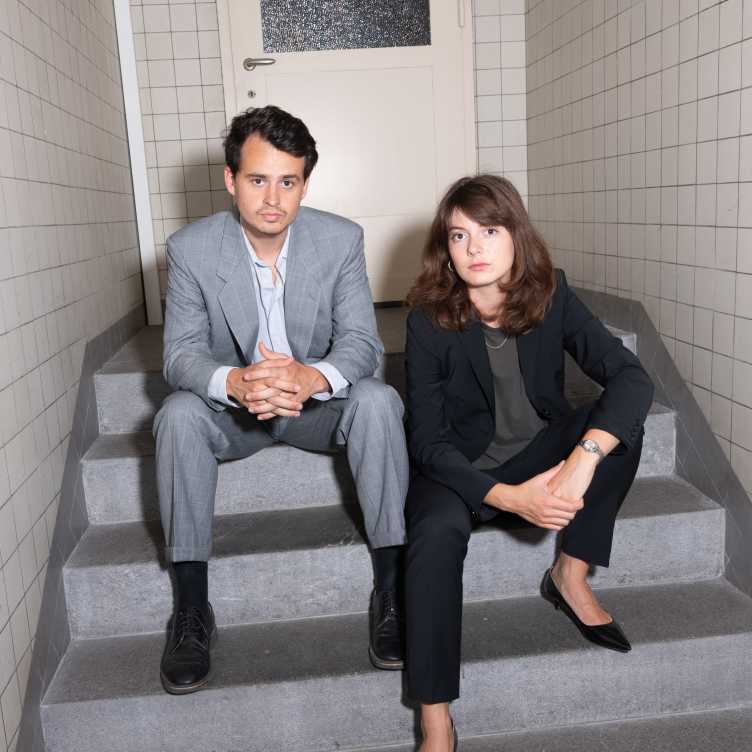
Schellinger Zaugg
Stefan Schellinger (1995, Walchwil) and Samantha Zaugg (1994, Frauenfeld) are studying in the Master Fine Arts at the Zurich University of the Arts. Together they are 348 centimeters tall.
external page https://samanthazaugg.ch
external page https://www.stefanschellinger.ch
Instagram: external page @frauzaugg and external page @555supercut

Yue Wu
The Mute Colours
2023
6-channel-video installation, audio recording (Dr. C. Schnadt Poberaj, Dr. P. Pothapakula, Prof. R. Jnglin Wills, Prof. N. Buchmann)
Duration: 35 min 42 sec
The Mute Colours is a six-channel video installation based on conversations with three climate scientists and one environmental scientist. Yue Wu’s interviews with experts on the perception of climate change are juxtaposed with images from the news, climate models and other visualisations of climate change. Colour plays an important role – monochrome colour fields covering the entire screen serve to structure the image-based narrative which is accompanied by audio of the scientists’ voices.
The use of the colours is inspired by the Warming Stripes created by scientist Ed Hawkins. The colours used here were originally extracted from minerals and plants. By researching ancient Chinese Buddhist sculptures and traditional Japanese colours, Yue Wu determined the origin of colours and their codes for digital production.
The installation reflects on the urgency of understanding climate change; the cause of climate change, the introduction of greenhouse gases, such as carbon dioxide and methane, and how climate change affects life; while the narration of the audio recording comes to the definition of three important ecosystem types in Switzerland; are they affected by climate change? How do they influence climate change?

Yue Wu's artistic practice is about "time" and "femininity".
Time, or duration, as an expanded, non-linear gesture, is her chosen perception of the happening. To visualize that, she uses the looping of sound and multiple video pieces combined with diverse technologies to build interactive installations.
She deeply identifies with femininity. Performance Art and Photography are the expression approaches.
external page https://www.yuewu.website/
Instagram: external page @yuew_u
Imprint
- ETH-Klimarunde is an event of the Center for Climate Systems Modeling (C2SM). This years Klimarunde is jointly organised by C2SM, the Energy Science Center (ESC) and the external page Zurich University of Arts (ZHdK)
- Project lead: Tamara Bandikova (C2SM)
- Project team: Tamara Bandikova (C2SM), external page Nicola Genovese, (ZHdK), Reto Knutti (C2SM), Tanja Meier (C2SM), Christian Schaffner (ESC), Christina Poberaj Schnadt (C2SM), external page Cornelia Schwierz (MeteoSwiss), Annina von Mentlen (ESC), external page Judith Welter (ZHdK)
- Curator: external page Judith Welter (ZHdK)
- Graphics exhibition: external page Martin Andereggen (ZHdK)
- Graphics ETH-Klimarunde: Tanja Meier (C2SM)
- Photographer ETH-Klimarunde: external page Tom Kawara
- Photographer exhibition: Cédric Mussano
